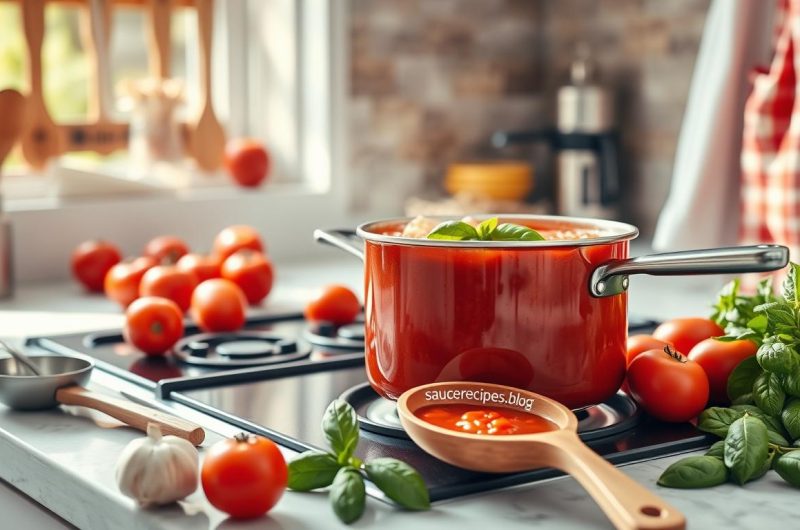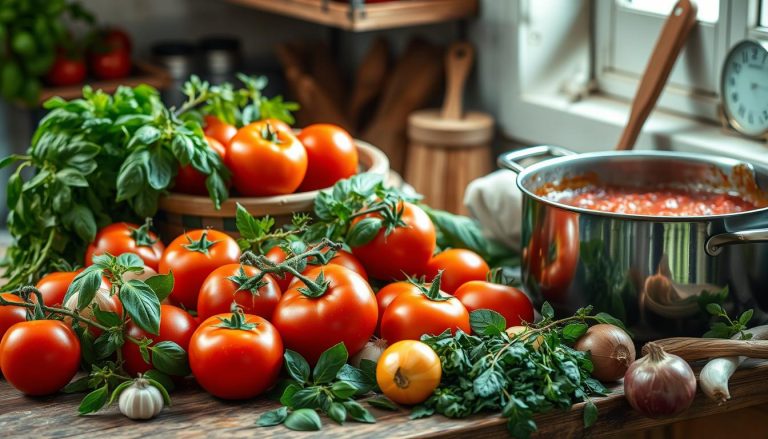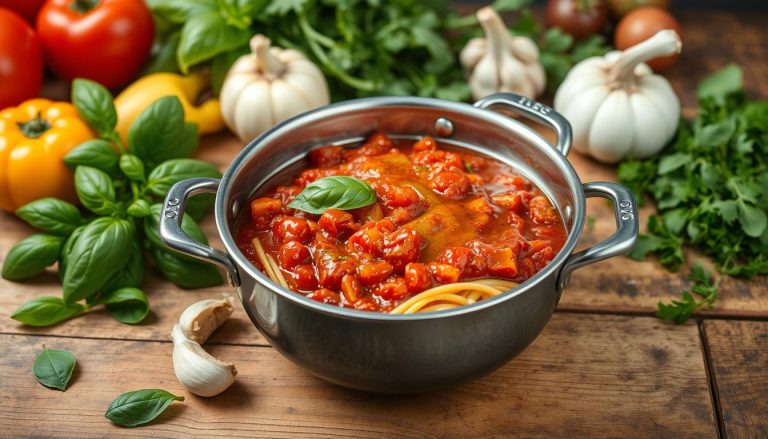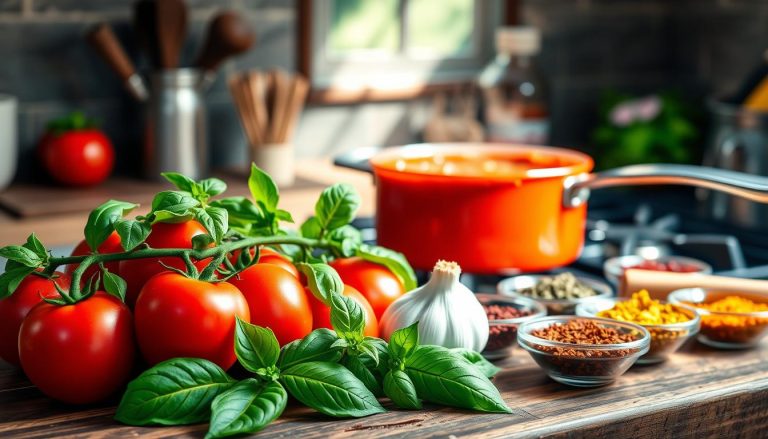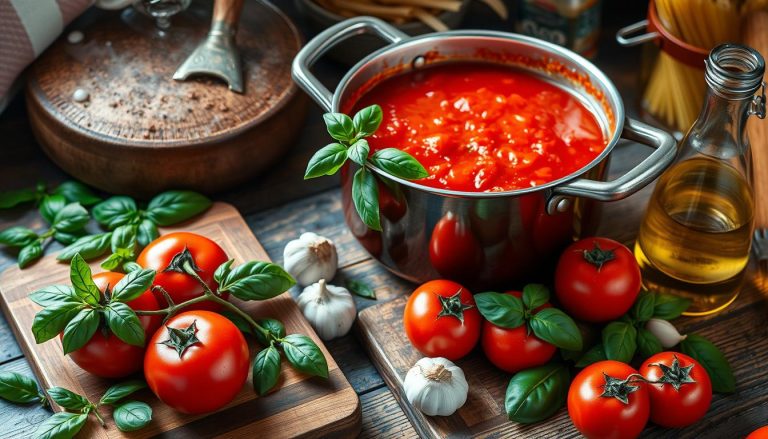low oxalate tomato sauce recipe
Details
4 Servings
15 minutes
25 minutes
695 calories
Following a low oxalate diet can be tough, finding tasty and healthy tomato sauce options is key. About 80% of kidney stones are made of calcium oxalate. So, it’s important to keep oxalate intake low, around 100-200mg a day, while also getting enough calcium.
Imagine enjoying your favorite pasta dishes without the worry of high oxalate content in traditional tomato sauces. A low oxalate diet can help prevent calcium oxalate stones. With the right recipe, you can enjoy the flavors of Italy while keeping your kidneys healthy. We’ll look into low oxalate tomato sauce recipes and kidney-friendly options for your diet.
Looking for a low oxalate tomato sauce recipe for pasta or as a dipping sauce? We’ve got you covered. Our aim is to guide you in making delicious and healthy low oxalate tomato sauce recipes that fit your dietary needs.
Table of Contents
Key Takeaways
- A low oxalate diet typically limits oxalate intake to 100-200mg per day.
- Low oxalate foods generally contain less than 10 mg of oxalate per serving.
- A low oxalate tomato sauce recipe can help reduce the risk of calcium oxalate stones.
- Kidney-friendly tomato sauce options are essential for those following a low oxalate diet.
- Our low oxalate tomato sauce recipe is perfect for pairing with pasta or as a dipping sauce.
- Low oxalate diet may reduce the risk of calcium oxalate stones, the most common type of kidney stones.
Understanding Low Oxalate Diets and Tomato Sauce
Keeping your kidneys healthy means following a low oxalate diet. This diet helps you add a kidney stones prevention recipe, like low oxalate sauce, to your meals.
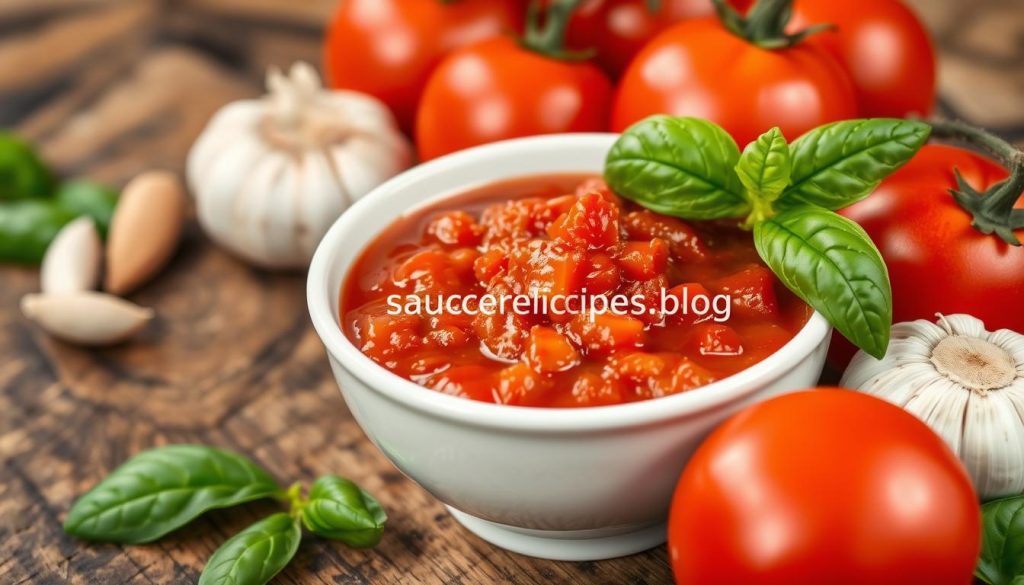
What are Oxalates?
Oxalates are found in many foods naturally. Eating too much of them can cause kidney stones. It’s important to watch how much oxalate you eat, if you have kidney problems.
Why Traditional Tomato Sauce is High in Oxalates
Traditional tomato sauces have ingredients like spinach and nuts. These are high in oxalates. So, they’re not good for people who need to avoid oxalates to prevent kidney stones.
Benefits of Low Oxalate Alternatives
Choosing low oxalate sauce has many benefits. It lowers the chance of getting kidney stones. You can also enjoy tasty meals without harming your health. Plus, it makes sticking to a diet easier over time.
Health Benefits of Making Your Own Low Oxalate Sauce
Making your own low oxalate sauce lets you control your kidney health recipes. You can pick each ingredient carefully. This way, you can make sure your sauce is oxalate-friendly and tastes great.
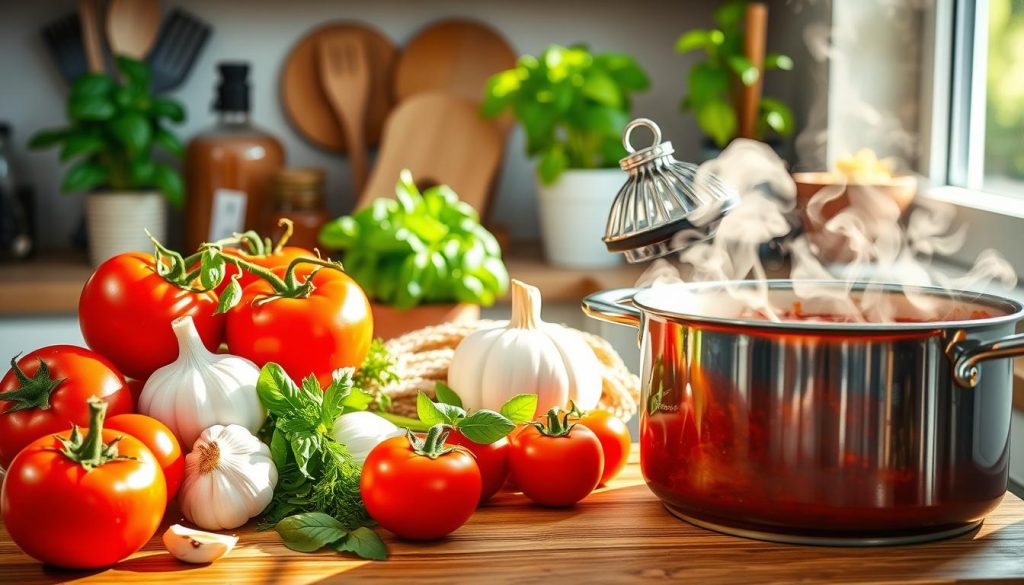
Homemade sauces avoid additives and preservatives found in store-bought ones. This makes your meals better and helps your health. It reduces the intake of harmful chemicals.
Also, making your sauce helps you watch sodium levels. This is key for those on the Kidney Stone Diet®. Keeping sodium low stops calcium from building up in urine. This lowers the risk of kidney stones.
- Improved Nutrient Control: Choose fresh, quality ingredients for better nutrition.
- Customization: Change flavors and textures to fit your diet and taste.
- Cost-Effective: Save money by making sauces at home instead of buying them.
Using low oxalate cooking with homemade sauces is good for your kidneys. It also makes cooking more fun and mindful.
Essential Ingredients for Low Oxalate Tomato Sauce
Making a tasty low oxalate pasta recipe starts with picking the right ingredients. Choose alternatives that taste like traditional tomato sauce but have less oxalates. This way, you can enjoy your favorite dishes without worrying about oxalates.
Low Oxalate Base Ingredients
Use butternut squash or pumpkin instead of tomatoes for your sauce. These veggies give a creamy texture and a sweet taste. For example, Dave’s Gourmet has a butternut squash sauce that’s both tasty and low in oxalates.
Herbs and Seasonings
Make your sauce better with herbs and seasonings. Here are some good ones:
- Basil
- Oregano
- Garlic powder
- Black pepper
- Red pepper flakes
These add flavor and smell without raising oxalate levels.
Optional Add-ins
Add veggies like bell peppers, zucchini, or spinach in small amounts. You can also add proteins like ground turkey or tofu for more substance. These choices let you make the sauce your own while keeping it low acid pasta sauce recipe.
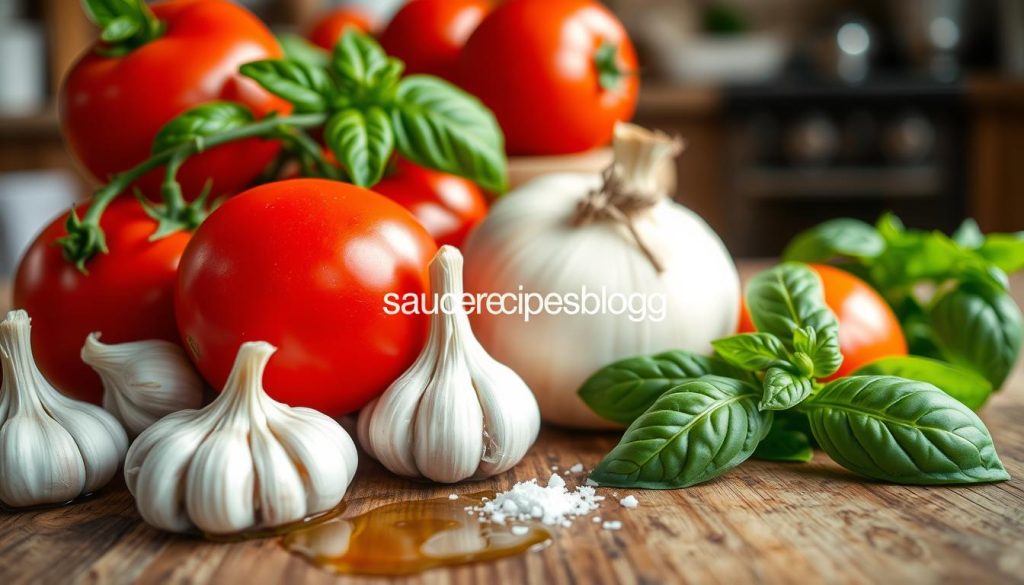
Kitchen Equipment You’ll Need
Making your own low oxalate tomato sauce is rewarding and healthier. To start, you need the right kitchen tools.
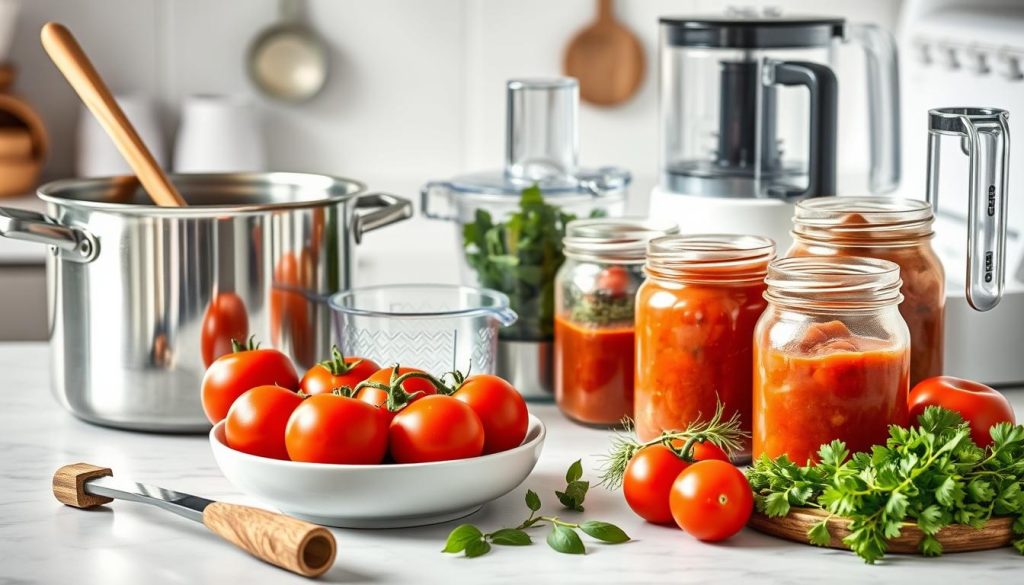
- Large Pot: A sturdy pot is necessary for simmering your sauce to perfection.
- Blender or Food Processor: Makes your nomato sauce recipe easy by ensuring a smooth consistency.
- Strainer: Helps remove any unwanted bits, giving your sauce a silky texture.
- Measuring Cups and Spoons: Accurate measurements are key to balancing flavors.
- Cutting Board and Knife: Essential for chopping vegetables and herbs efficiently.
If you don’t have a blender, a hand mixer can be a great alternative. These tools not only make the process easier but also help you create sauces that rival popular low acid pasta sauce brands. Investing in quality equipment can enhance your cooking experience and the final taste of your homemade sauce.
Step-by-Step Low Oxalate Tomato Sauce Recipe
Making your own low oxalate tomato sauce is easy and fun. Follow these steps to create a tasty sauce that meets your dietary needs.
Preparation Steps
- Gather all ingredients, including low oxalate base ingredients like butternut squash and herbs.
- Wash and chop vegetables into even pieces for uniform cooking.
- Measure out spices such as oregano and basil to enhance the flavor.
Cooking Instructions
Start by sautéing the chopped vegetables in a large pot over medium heat until they soften. Add the measured herbs and spices, stirring to combine. Then, pour in low oxalate broth and let it simmer for 20 minutes. This allows the flavors to blend well.
Adjusting Consistency
If you want a thicker sauce, use an immersion blender to puree the mixture in the pot. For a thinner sauce, add more broth or water until it’s right. Taste and adjust the seasoning as needed to make your low oxalate recipe perfect.
| Ingredient | Quantity | Calories |
|---|---|---|
| Butternut Squash | 2 cups | 100 |
| Olive Oil | 2 tablespoons | 240 |
| Herbs (Oregano, Basil) | 1 teaspoon each | 5 |
| Low Oxalate Broth | 4 cups | 40 |
| Salt and Pepper | To taste | 0 |
Flavor Variations and Adaptations
Exploring flavor variations can make your nomato sauce without beets exciting. By changing herbs and spices, you can create many different tastes. These can fit various cuisines and keep oxalate levels low.
Here are some ideas to get you started:
- Italian-Inspired: Add basil, oregano, and thyme for a classic taste. Incorporate garlic and a touch of olive oil to enhance the richness.
- Mexican-Inspired: Mix in cumin, coriander, and smoked paprika. A squeeze of lime can add a fresh zing to your sauce.
- Indian-Inspired: Use turmeric, ginger, and garam masala. These spices bring warmth and depth to your tomato sauce.
Feel free to experiment with different low oxalate ingredients. Tailor the sauce to your preferences. Knowing is tomato sauce low in oxalates? helps you make healthy choices without losing flavor.
A low oxalate diet is a chance to find new foods and flavors. It’s a chance to create unique sauces. These sauces meet your dietary needs and also please your taste buds.
Common Mistakes to Avoid
Learning to make low acidic tomato sauce can be tricky. But, by avoiding common mistakes, you can make a delicious and safe sauce. Here are some key areas to watch:
Temperature Control Issues
Keeping the right temperature is key. Cooking too high can burn the sauce, while too low can stop it from tasting right. Use steady heat and stir often to keep the temperature just right.
Seasoning Errors
Too much or too little seasoning can mess up your sauce’s taste. Start with a little bit of herbs and spices and taste as you go. This way, you can get the flavor just right without overpowering the tomatoes.
Storage Mistakes
Storing your sauce wrong can cause it to spoil or lose flavor. Cool it down, then put it in airtight containers and refrigerate it fast. Marking the containers with the date helps you remember how long it’s been there.
| Common Mistake | Solution |
|---|---|
| Overcooking leading to burnt sauce | Use moderate heat and stir frequently |
| Incorrect seasoning amounts | Add spices gradually and taste regularly |
| Improper storage causing spoilage | Store in airtight containers and refrigerate promptly |
Storing and Preserving Your Sauce
Proper storage keeps your low oxalate tomato sauce fresh and tasty. It ensures the sauce’s flavor and health benefits last longer.
Store your sauce in airtight containers in the fridge. It can stay good for up to a week. Freezing is another great way to keep it longer.
Freezing requires using jars or bags safe for the freezer. Be sure to label them with the date. This way, you can enjoy your sauce for up to three months.
Divide your sauce into smaller portions before storing. This makes it easier to use and helps avoid waste. It also lets you grab the right amount without thawing the whole batch.
To reheat, warm the sauce gently on the stove or in the microwave. Avoid high heat to keep the flavor and nutrients intact.
| Storage Method | Duration |
|---|---|
| Refrigeration | Up to 1 week |
| Freezing | Up to 3 months |
Pairing Suggestions and Serving Ideas
Make your meals better by using low oxalate tomato sauce. It’s good for your diet and adds great taste to your food.
Perfect Pasta Pairings
There are many pasta choices that go well with low oxalate tomato sauce:
- Traditional Pasta: Whole wheat or gluten-free pasta is a good choice.
- Low Oxalate Pasta: Pasta made from rice, corn, or quinoa is best to avoid oxalates.
These pasta types make your meal tasty and good for your stomach.
Other Serving Options
Try these ideas to make your meals more interesting:
- Casseroles: Use the sauce as a base for vegetable and protein casseroles.
- Pizza Base: Spread the sauce on your favorite pizza crust.
- Dipping Sauce: Serve it with fresh veggies or whole grain crackers.
Changing your diet slowly is key to staying healthy. Using low oxalate tomato sauce in different ways keeps your meals tasty and good for you.
| Serving Idea | Description |
|---|---|
| Pasta Dishes | Combine with traditional or low oxalate pasta for a hearty meal. |
| Casseroles | Use as a flavorful base for baked vegetable and protein dishes. |
| Pizza Base | Spread on pizza crust for a low oxalate alternative. |
| Dipping Sauce | Serve with fresh veggies or whole grain crackers for a healthy appetizer. |
Alternative Ingredients for Different Dietary Needs
Adjusting your low oxalate tomato sauce recipe for different diets makes it enjoyable for everyone. It’s perfect for those on a vegan, gluten-free, or other specific diet. There are many alternatives to choose from.
- Vegetable Substitutes: Swap potatoes for celery root or butternut squash. This keeps the sauce smooth and low in oxalates.
- Protein Options: Use black-eyed peas instead of black beans. Or, choose chickpeas over white beans for a kidney-friendly sauce.
- Dairy Alternatives: Pick coconut milk or regular cow’s milk over almond milk. This avoids high oxalate levels.
- Bread and Cereal Substitutes: Go for Corn Chex, Rice Chex, or Rice Krispies. They’re better than high-oxalate cereals like Shredded Wheat.
- Flavor Enhancers: Use ginger or chamomile tea instead of black or green tea. They add flavor without oxalates.
Start making small changes to your sauce to keep its flavor and texture. Begin by swapping one ingredient at a time. This lets your taste buds adjust slowly.
Here’s a quick reference table for some effective substitutions:
| Ingredient | Low Oxalate Substitute | Notes |
|---|---|---|
| Potatoes | Celery Root or Butternut Squash | Provides similar texture without high oxalate content |
| Black Beans | Black-eyed Peas | Lower in oxalates and kidney-friendly |
| Almond Milk | Coconut Milk or Cow’s Milk | Avoids high oxalate content while maintaining creaminess |
| Peanut Butter | Sunflower Seed Butter | Less oxalate and suitable for various diets |
Tips for Achieving the Perfect Consistency
Getting your low oxalate tomato sauce just right is all about finding the right balance. You might want it thick and hearty or light and smooth. These tips will guide you in making it just the way you like it.
Thickening Methods
- Blend in pureed vegetables like carrots or zucchini for natural thickness.
- Use tomato paste to add depth and body without increasing oxalate levels.
- Simmer the sauce longer to reduce excess liquid.
Thinning Techniques
- Add low-sodium vegetable broth to achieve a smoother consistency.
- Incorporate a splash of water or low oxalate vegetable juice if the sauce is too thick.
- Stir in a bit of olive oil for a silkier texture.
| Recipe | Calories | Fat (g) | Carbs (g) | Fiber (g) | Net Carbs (g) | Protein (g) | Sodium (mg) |
|---|---|---|---|---|---|---|---|
| Low Oxalate Tomato Sauce | 57 | 5.13 | 1.78 | 0.99 | 0.79 | 1.62 | 17 |
| Pumpkin Cake | 295 | 25.8 | 7.28 | 2.30 | 4.98 | 12.4 | 287 |
| Tamale Pie | 493 | 31.5 | 10.1 | 2.4 | 7.7 | 39.8 | 882 |
Nutritional Information and Health Considerations
Making an oxalate-conscious meal like this low oxalate sauce is good for your kidneys and offers balanced nutrition. Each serving has about 80 calories, 2 grams of protein, 15 grams of carbs, and 3 grams of fat.
This low oxalate sauce has much less oxalate than regular tomato sauces. It’s great for people who need to watch their oxalate intake. Foods on the Simple & Safe Oxalate List have less than 45 mg per serving, making them safe to eat.
- Calories: 80 kcal
- Protein: 2g
- Carbohydrates: 15g
- Fat: 3g
- Oxalate Content: Below 45 mg per serving
This sauce is also good for people with acid reflux or other digestive problems. It has fewer ingredients that can cause discomfort. Eating foods rich in calcium helps remove oxalates from your body, which is good for your bones.
| Nutrient | Amount per Serving |
|---|---|
| Calories | 80 kcal |
| Protein | 2g |
| Carbohydrates | 15g |
| Fat | 3g |
| Oxalates | Below 45 mg |
Troubleshooting Common Issues
When making oxalate-friendly recipes, you might face some common problems. Solving these issues can make your low oxalate cooking a success.
Texture Problems
If your sauce is grainy or separates, it might be because of uneven cooking or wrong ingredient ratios. To solve this, blend the sauce well or adjust the liquid parts. Adding a low oxalate thickener like xanthan gum or arrowroot powder can also help.
Flavor Adjustments
Your sauce might taste too sweet, acidic, or bland. To fix this, taste it as you go and make small changes. Adding herbs like basil or oregano can add depth. If it’s too acidic, a bit of baking soda can help. For sweetness, try a low oxalate sweetener like brown sugar.
| Issue | Possible Cause | Solution |
|---|---|---|
| Grainy Texture | Unblended ingredients | Use a blender to smooth the sauce |
| Separation | Incorrect ingredient ratios | Adjust liquid components and stir well |
| Too Sweet | Excess sweeteners | Add more acidic ingredients like lemon juice |
| Too Acidic | High acid ingredient proportion | Add a pinch of baking soda to neutralize |
| Bland Taste | Lack of seasoning | Incorporate herbs and spices like oregano or basil |
Conclusion
Creating delicious low oxalate tomato sauce recipes can boost your kidney health. Making your own sauce lets you pick ingredients that are good for you. This way, you don’t have to give up flavor.
This recipe is easy to customize with your favorite herbs and add-ins. You can use it with pasta or as a base for other dishes. These low acid pasta sauce recipes are great for adding variety to your meals.
Adding recipes like this to your diet helps your kidneys and makes meals more interesting. Try this recipe today and see how tasty and healthy it can be. Share your own versions to help others on their health journey.
FAQ
Is tomato sauce low in oxalates?
How do you make low acidic tomato sauce?
What is a healthy substitute for tomato sauce?
What is a good substitute for tomato sauce for acid reflux?
What are five fast pasta sauces without tomatoes?
Is there an easy nomato sauce recipe?
Can you make nomato sauce without beets?
What are some low acid pasta sauce brands?
Do you have a no tomato sauce recipe?
What are some low oxalate pasta recipe ideas?
low oxalate tomato sauce recipe
Course: tomato sauceCuisine: ItalianDifficulty: Easy4
servings15
minutes25
minutes695
kcal40
minutesThis low oxalate tomato sauce is a simple, healthy, and flavorful option for those following a low-oxalate diet. Made with fresh tomatoes, garlic, and herbs, it’s perfect for pasta, pizza, or as a base for other dishes. Quick to prepare and full of vibrant flavors!
Ingredients
4 cups peeled and deseeded fresh tomatoes (or canned low-sodium tomatoes)
1 large onion, finely chopped
4 cloves garlic, minced
4 tablespoons olive oil
1 cup low-sodium chicken or vegetable broth (optional, for a thinner sauce)
2 teaspoons dried basil
2 teaspoons dried oregano
1 teaspoon salt (adjust to taste)
1/2 teaspoon black pepper
2 teaspoons sugar or honey (optional, to balance acidity)
Directions
- Prepare the Tomatoes
If using fresh tomatoes, blanch them in boiling water for 1-2 minutes until the skins start to peel. Cool, then peel and deseed the tomatoes. Chop into small pieces. - Sauté Aromatics
Heat the olive oil in a large saucepan over medium heat. Add the chopped onions and sauté for 3-5 minutes until softened and translucent.
Add the minced garlic and cook for an additional 1 minute, stirring frequently to avoid burning. - Cook the Sauce
Add the prepared tomatoes (or canned tomatoes) to the pan. Stir well to combine with the onions and garlic.
Pour in the broth if you prefer a thinner sauce.
Add basil, oregano, salt, and pepper. Stir to combine all ingredients. - Simmer and Adjust Seasoning
Reduce the heat and let the sauce simmer for 20-25 minutes, stirring occasionally. This helps the flavors meld together.
Taste and adjust seasoning as needed. Add sugar or honey to balance acidity if desired. - Blend for Smoothness (Optional)
Use an immersion blender directly in the pot or transfer the sauce to a countertop blender for a smoother texture. - Serve or Store
Serve the sauce over pasta, rice, or as a pizza sauce.
Store any leftovers in an airtight container in the refrigerator for up to 5 days, or freeze for up to 3 months.
Notes
- Fresh vs. Canned Tomatoes:
Fresh tomatoes offer a more vibrant, natural flavor but require extra time to peel and deseed. Canned low-sodium tomatoes are a convenient option and can save you time in preparation.
Adjusting Consistency:
If you prefer a thicker sauce, allow it to simmer longer to reduce. For a thinner sauce, add extra broth or water during the cooking process.
Sweetness:
Tomatoes can sometimes be acidic, especially when using canned varieties. Adding a teaspoon of sugar or honey can help balance this acidity. Adjust the sweetness based on your taste preference.
Flavor Variations:
Feel free to experiment with other herbs like thyme, rosemary, or parsley for added depth of flavor. You can also add a pinch of red pepper flakes for a little heat.
Storage Tips:
Store leftover sauce in the fridge for up to 5 days, or freeze for up to 3 months. Consider freezing in individual portions for easy use later.


